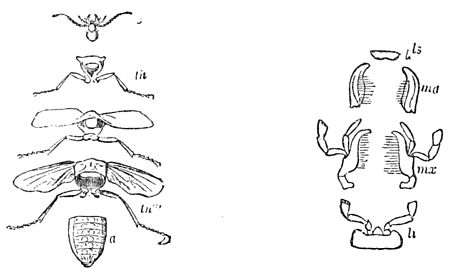the hood, prolonging the front, and running down in front of the mouth. The head is generally articulated with the prothorax by a fine ligament, which leaves it more or less freedom of motion in all directions.
The mouth of insects is arranged to masticate, lick, or suck food. The buccal parts are of course fitted to their purpose, but the type to which all should be referred is the masticatory apparatus, which, by repeated applications to functions foreign to its

| Fig. 6.—Parts of which the Body of a Coleopter is composed. c, head; th', first ring; of the thorax (prothorax); th", second ring of the thorax (mesothorax); th'", third ring of the thorax (metathorax); a, abdomen. | Fig. 7.—Mouth of a Masticating Insect. ls, labrum; md, mandibles; mx, jaws and maxillary palpi; h, lower lip and labial palpi. |
primary destination, has been insensibly modified and at last transformed, according to circumstances, into a licking or sucking apparatus. The buccal organs of masticating insects move laterally, after the manner of scissors, while the jaws of vertebrates work up and down, like pincers.
When we examine the mouth of the masticating insect, we find in it parts in the order indicated in Fig. 7. First is an upper lip, or labrum, ls; second, a pair of upper jaws, or mandibles, md; third, a pair of lower jaws furnished with maxillary palpi, mx; and fourth, a pair of labial palpi supported by a lower lip, h, which is itself attached to the border of the buccal cavity forming the chin. The articulated mandibles on the cheeks are strong pincers, which sometimes attain a very considerable development. They are often dentated on their inner border.
The lower jaws are composed of several pieces. Their inner lobe is frequently furnished with a brush of silky threads, and sometimes ends in a little mobile tooth, such as may be remarked among the Cicindelæ, (Coleoptera). The outer lobe is often articulated in the same way as the palpi. The insect may then be regarded as having two pairs of maxillary palpi.
